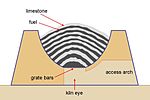
The common feature of early kilns was an egg-cup shaped burning chamber, with an air inlet at the base (the "eye"), constructed of brick. Limestone was crushed (often by hand) to fairly uniform 20-60 mm (1 to 2.5 inch) lumps - fine stone was rejected. Successive dome-shaped layers of coal and limestone were built up in the kiln on grate bars across the eye. When loading was complete, the kiln was kindled at the bottom, and the fire gradually spread upwards through the charge. When burnt through, the lime was cooled and raked out through the base. Fine coal ash dropped out and was rejected with the "riddlings".

Cross section of typical early kiln
Only lump stone could be used, because the charge needed to "breathe" during firing. This also limited the size of kilns and explains why kilns were all much the same size. Above a certain diameter, the half-burned charge would be likely to collapse under its own weight, extinguishing the fire. So kilns always made 25-30 tonnes of lime in a batch. Typically the kiln took a day to load, three days to fire, two days to cool and a day to unload, so a one-week turnaround was normal. The degree of burning was controlled by trial and error from batch to batch by varying the amount of fuel used. Because there were large temperature differences between the center of the charge and the material close to the wall, a mixture of under-burned (i.e. high loss on ignition), well-burned and dead-burned lime was normally produced. Typical fuel efficiency was low, with 0.5 tonnes or more of coal being used per tonne of finished lime (15 MJ/kg).
The lime production was sometimes at an industrial scale. One example at Annery in North Devon, near Torrington, was made up of three kilns grouped together in an 'L' shape and was situated beside the Torrington canal and the River Torridge to bring in the limestone and coal, and to transport away the calcined lime in the days before properly metalled roads existed.
Sets of seven kilns were common. A loading gang and an unloading gang would work the kilns in rotation through the week.
The large kiln at Crindledykes near Haydon Bridge, Northumbria, was one of more than 300 in the county. It was unique to the area in having four draw arches to a single pot. As production was cut back, the two side arches were blocked up, but were restored in 1989 by English Heritage.
The development of the national rail network increasingly made the local small-scale kilns unprofitable, and they gradually died out through the 19th century, replaced by larger industrial plants. At the same time, new uses for lime in the chemical, steel and sugar industries led to large-scale plants. These also saw the development of more efficient kilns.
A 'lazy kiln' was the name given to a lime kiln which only saw intermittent use.